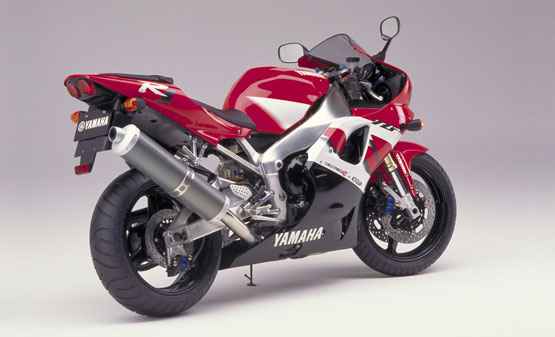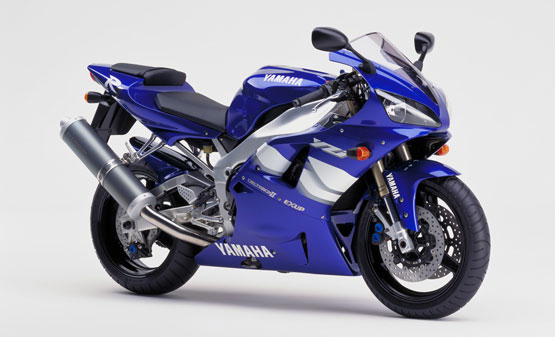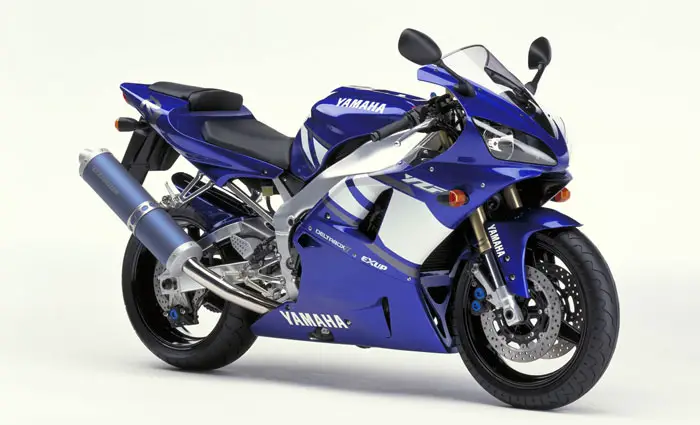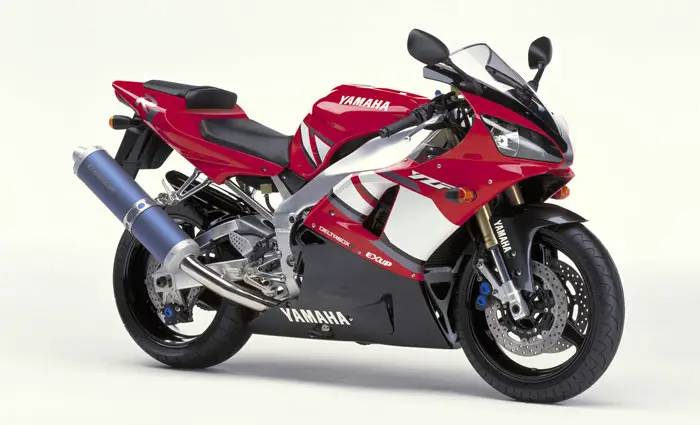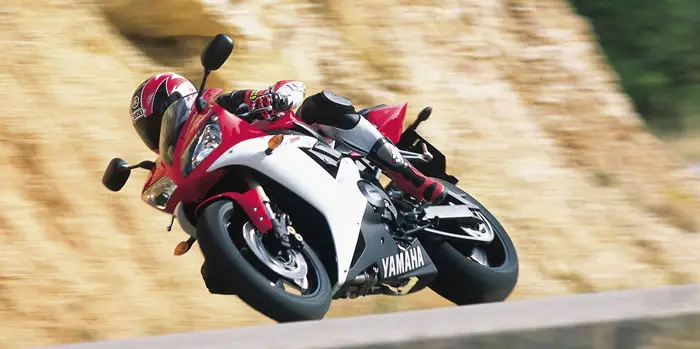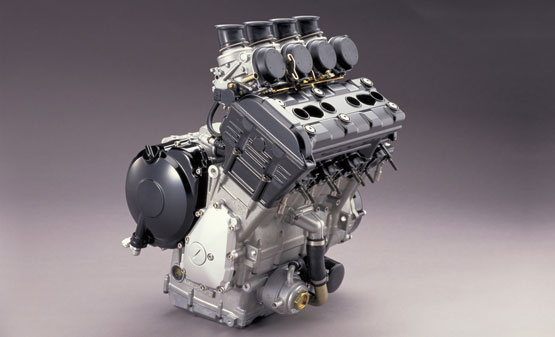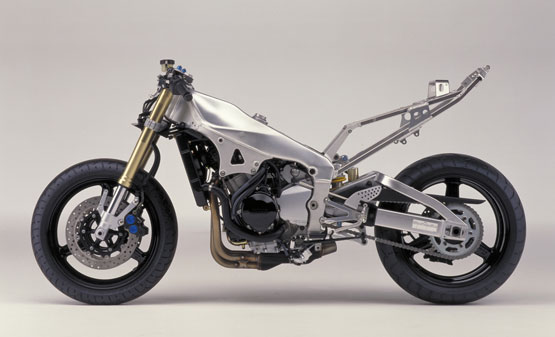Back to the Model History Timeline Review Page
2000 to 2001 – The world is a curve – Second Generation R1/YZF-R1
Page 3 of 7
<< Page Back – Page Forward >>
“The ultimate cornering Master (Yamaha R1/YZF-R1)” – Yamaha
2000 Yamaha R1/YZF-R1
The model update in 2000 was aimed at improving the handling and creating a more linear throttle response. Using the same basic components and layout the engineers fine-tuned many details to maximise the potential of the motorcycle. The most noticeable detail changes were the modified carburettor settings, reduced frictional losses in the engine, improved gearbox and many weight-saving changes throughout the model.
The silencer was changed to titanium and the bike’s bodywork was totally new.
Emissions were reduced in accordance to EU-1 regulations by an air intake system (AIS). Total weight was reduced to 175 kg.
2001 Yamaha R1/YZF-R1
The year 2001 saw a new colouring and graphics scheme used to keep the YZF-R1 popular and up-to-date.
R1 The world is a curve: Cornering that’s what supersport is all about!
Second generation R1: the engineers focused on cornering and handling.
Nicknamed THE ONE, the second generation R1 focuses on what supersport excitement is all about: cornering, enjoyment of winding roads and racetrack.
In the past the increase of horsepower and top speed triggered the interest of many supersport riders, high performance machines of top capacity categories have reached a level, which requires a constant attention from the rider, when riding at higher speed.
Yoshikazu Koike took over the project leadership from Kunihiko Miwa nicknamed “Mr. No Compromise”, who is the legendary creator of the original R1. He describes the key-points of the new development: “Our biggest challenge was how to keep the great qualities of the R1 while continuing its evolution to a new level. Our aim was creating a machine that responds directly to the rider’s actions and a very high level of cornering performance.”
Riders confirmed the direction. Hennes Fischer, product planning consultant: “I felt at home on THE ONE already after the first corner. I attacked the corners in Fukuroi (Fukuroi is a Yamaha test track in Japan) as if I knew the bike already for a while. The whole package, riding position, suspension setup and performance control work so nicely together, that you never feel fighting against the bike, but the bike assists you in your actions. In other words: THE ONE brakes as you order it through the lever, it flips into corners with your body movements and it accelerates precisely every millimeter of throttle opening. The bike is like a top level aerobatics – its precision flying.”
THE ONE is demanding on the other hand: To enjoy the potential of it you need experience and you have to ride it also with physical input and strength to be rewarded with the direct feed back of the machine. Body movement during cornering for example supports riding precision rather than disturbing it.
Hajime Nakaaki, responsible for chassis design of THE ONE explains how the engineers achieved the ‘YAMAHA handling’: “The key is the perfection in design of the steering assembly and the head pipe. Basically, achieving rigidity means: fixing the head pipe solid in place, and then making the pivot assembly resistant to distortion. But a motorcycle does not just drive straight but constantly has directional changes from left to right. We concentrated our efforts in perfecting this most basic character of a motorcycle as such.”
The changes included a complete new front fork with 15 mm lesser wheel travel ( 120 mm), a thicker inner tube and a thinner walled stock for the outer tube. Also a completely new designed 3rd generation of Deltabox frame with detachable rear subframe and the asymmetric rear arm as well as a modified rear suspension. The engine was raised by 20 mm to concentrate the mass around the rolling axis. Even the rider position is nearer to the rolling axis to achieve YAMAHA handling.
Project leader Koike adds: “The place where we did discuss and exchange opinions between us was the small meeting room behind the pit lane on our test track. This is one of the most important hidden specs you won’t see in any catalogue. I believe it is those high-powered meetings that led to the creation of this amazing machine that clears high EU2 emission standards and at the same time proposes the standard for next generation supersport.”
Experienced riders know: ‘power is nothing without control’. Just horsepower may be nice to show your friends in a glossy leaflet, but when it comes down to use such high power bikes like the R1 you need proper control. That is why the new R1 engine has its hidden strength supported by the new fuel injection system and a completely new EXUP exhaust management system. Kenji Abe, responsible for engine design explains: “For the first time on a production motorcycle we used a Vacuum-controlled Electronic Fuel Injection. This system allows an ideal air/fuel mixture in low rpm-range by controlling the air intake. It does not require complicated electronic controls and it combines the advantages of a carburetor with those of a today’s fuel injection. In other terms you can say it is a fusion of analog and digital.”
This system “fuel injection with suction piston” uses a free suction driven valve piston to regulate air intake flow independently from electronic control. This ensures an optimum air volume without “smart electronic interference”. On the other hand a microcomputer control collects data from various sensors to ensure an optimum fuel supply with the right air/fuel mixture. This is the secret giving THE ONE such direct throttle response.
(Interesting note: Yamaha used two suppliers with greatest experience in this field: Mikuni for the throttle sensor and Mitsubishi for the electronic control unit.)
The new lighter and more compact EXUP system in the exhaust system supports the fuel injection to maintain the best possible flow management of intake and exhaust gases. Two valves instead of one on the previous R1 are responsible for cylinder 1 & 4 respective 2 & 3. That’s why the R1 engine has such a high torque and control feeling over all its rpm range.
Product planner Shinichiro Nishimura is convinced: ” There are a lot of competitors out there in our industry, and if you were going to choose one model that shows what sets Yamaha apart from the rest, I think that this may be it! THE ONE will touch the heartstrings of the experienced supersport user and I think they know what really matters at this level of performance is Man Machine Communication.”
That’s what THE ONE is all about.
2000 Yamaha R1/YZF-R1 Specifications
Engine
Engine type Liquid-cooled, forward inclined parallel 4-cylinder, DOHC, 5-valve per cylinder
Displacement 998 cc
Bore x stroke 74.0 x 58.0 mm
Compression ratio 11.8 : 1
Maximum power 110.3 kW (150 HP) @ 10,000 rpm
Maximum torque 108.3 Nm (11.0 kg-m) @ 8,500 rpm
Lubrication system Wet sump
Fuel System BDSR40 with TPS system
Clutch type Wet, multiple disc
Starter system Electric
Transmission system 6 speed
Primary reduction ratio 1.581
Secundary reduction ratio 2.688
Final transmission Chain
Ratios gearbox 1st 2.500
Ratios gearbox 2nd 1.842
Ratios gearbox 3rd 1.500
Ratios gearbox 4th 1.333
Ratios gearbox 5th 1.200
Ratios gearbox 6th 1.115
Chassis
Chassis Aluminium Deltabox II
Front suspension system Telescopic fork, upside- down, Ø 41
Front wheel travel 135 mm
Rear suspension system Truss-type aluminium swinging arm Monocross system
Rear wheel travel 130 mm
Caster angle 24°
Trail 92 mm
Front brake Double-disc, Ø 298 mm
Rear brake Single disc, Ø 245 mm
Front tyre 120/70 ZR17
Rear tyre 190/50 ZR17
Front rim 17″ x MT3,50
Rear rim 17″ x MT6,00
Dimensions
Overall length 2,035 mm
Overall width 695 mm
Overall height 1,095 mm
Seat height 815 mm
Wheelbase 1,395 mm
Minimum ground clearance 140 mm
Dry weight 175 kg
Fuel tank capacity (reserve) 18 L
Specifications and appearance of Yamaha products shown here are subject to change without notice and may vary according to requirements and conditions. For further details please consult your Yamaha dealer.

